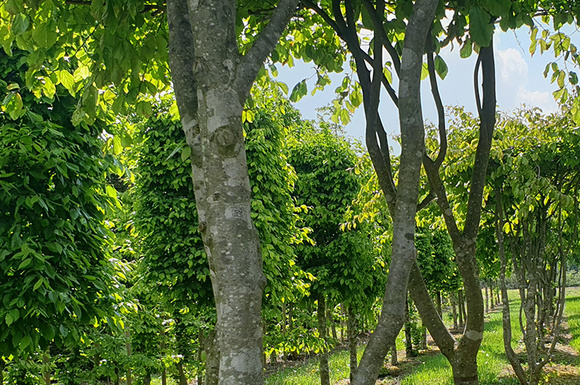Meerstammige parasolbomen of paraplubomen
- Reading time: 5 min.
- 609x

With the growing need for greenery, atmosphere, and privacy in our gardens, parasol trees (sometimes called umbrella trees) are attracting increasing interest. They are especially well-suited for creating a pleasant shaded area in your garden or on your terrace. Parasol trees provide a natural and green canopy to enjoy all year round. In this article, we focus on the multi-stemmed parasol tree. Thinking of buying one? This article offers expert answers to your questions.
- Tom
- 14 October 2025
In this article
What are parasol trees?
Parasol trees are naturally broad-crowned trees whose branches are pruned and/or trained to form a canopy resembling a parasol or roof. That’s why they’re also referred to as “roof trees.”
These trees are an ideal solution for natural sun protection. Their fine foliage allows them to cast shade over a generous area while still letting through enough sunlight.
Because parasol trees create pleasant shaded spots and transform garden zones into inviting spaces, they’re perfect for enjoying warm weather outdoors.
Parasol tree or umbrella tree? Can a parasol tree also serve as an umbrella tree? Absolutely. In light rain, it offers some shelter, allowing you to stay outside longer.
However, its true value lies in filtering sunlight. That’s why we prefer the term “parasol tree.” Thanks to its airy crown, light plays freely through it, giving the tree a fresh and cheerful appearance.
More benefits of parasol trees in your garden:
Suitable varieties exist for every soil type.
Limited root growth allows planting near terraces.
They filter sunlight without overly darkening the garden.
They add structure and rhythm to your outdoor space.
Parasol trees can be seen as a bridge between artificial structures and nature. Their form and structure offer the efficiency of a man-made parasol, but with the life and beauty of a tree.
They are living organisms, but without the disadvantages of large-growing trees — such as maintenance, root spread, space consumption, and excessive shading. A well-cultivated parasol tree avoids these issues.
Parasol trees remain a seasonal product. That’s why we offer them in pots, in a wide range of sizes. Potted parasol trees can be kept temporarily in containers, but we recommend planting them in open ground for long-term success.
Choose an evergreen parasol tree for your terrace
If you opt for a wintergreen variety, your parasol tree will stay lush even in colder months. We recommend this type only in specific situations, such as sun filtering for indoor light control or privacy-focused applications.
You can also choose deciduous parasol trees that transform your garden and terrace into a vibrant autumn display. Every parasol tree has its own beautiful color palette — even those without striking fall colors. Through their foliage, you experience the rhythm of the seasons.
What types of parasol trees are there?
In general, we distinguish between single-stemmed and multi-stemmed parasol trees. At Espaliers, we also work with a broader classification: standard parasol trees and natural parasol trees.
Standard parasol trees
These trees resemble the artificial version: a straight trunk with a neatly shaped canopy.
Natural parasol trees
Our natural parasol trees evoke the feeling of a real tree, without its disadvantages. They offer the atmosphere of a tree without excessive size or shade.
They feature natural trunk shapes such as artistic or multi-stemmed bases, and informal, organically grown canopies. These forms create contrast in structured gardens and blend harmoniously into natural designs. Our nursery specializes in cultivating this type of tree.
At Espaliers, you’ll also find unique in-house models: asymmetrical parasol trees and artistic parasol trees, with or without multiple stems.
When it comes to species, the most well-known are the roof plane tree and the roof mulberry. But the best choice depends on your project. Feel free to consult our experts at Espaliers. This helpful article can also guide you: Key considerations when choosing a parasol tree.
Multi-stemmed parasol trees
Multi-stemmed parasol trees are our specialty. Their unique characteristics add aesthetic and artistic value to your outdoor space.
They branch into multiple stems right from the base, creating a playful and open structure. This dynamic form never gets boring. Depending on your needs, you can choose a slender and elegant model or a more complex and fascinating trunk composition.
Above, the canopy is well-distributed, with foliage spread across a wide surface, offering pleasant shade. The crown can be formally structured or more natural, depending on your style and requirements.
Multi-stemmed parasol trees are ideal for creative applications — from shade trees to statement pieces or playful garden elements. The possibilities are vast.
At our nursery, you’ll be inspired by beautiful specimens. Still, the most important aspect is integration — and we give it the attention it deserves.
How to care for parasol trees
A well-grown parasol tree requires little maintenance. Some varieties only need occasional attention.
Still, regular follow-up is recommended for three reasons:
To maintain the desired size
To keep the canopy fresh and open
To guide the tree’s growth direction
Our next article covers pruning roof plane trees, but the general principles apply to most parasol trees: Proper pruning of roof plane trees.
Espaliers: expert in quality parasol trees
No matter which type you choose, Espaliers guarantees top-quality parasol trees. Our trees are cultivated with passion, experience, and deep horticultural expertise.
Our multi-stemmed parasol trees are natural gems, available in various sizes — so we can always offer the most suitable specimen for your garden project.
Feel free to contact our professionals. Together, we’ll find the single- or multi-stemmed parasol tree that best fits your vision.
Would you like to learn more about multi-stemmed parasol trees, share an insight, or request tailored advice? You're welcome to visit us or explore a collaboration. Book your appointment below.
Related articles
